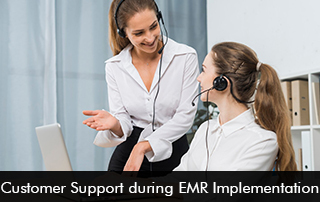Implementing Electronic Medical Records (EMR) Software is a complex process requiring EHR vendor support. When strong customer support is offered to healthcare providers and end-users, there is a chance of reduced frustration, and it ensures that software deployment is smooth, leading to future success. Customer support from the EMR Software vendor is crucial in enhancing care quality and the overall user experience.
Types of Customer Support Options
EMR Software vendors work hard to offer strong support for their clients, ensuring their success, because they are aware that healthcare practitioners rely on their systems for patient care and administrative activities. Vendors of EHR software frequently provide the following features of customer service:
- Technical support
- Training and onboarding
- User guides, manuals, and documentation
- 24/7 customer support availability
- Remote assistance
- Dedicated account managers or customer success teams
- Customization and integration support
- Compliance and regulatory support
- Online user forums
- Data backup and recovery
EMR Software Vendors with the Best Support According to KLAS
Vendor Comparison: Implementation Support Strengths
| EMR Software Vendor | KLAS 2025 Performance | EMR Software Implementation Support Highlights |
| Epic Systems | Best in Overall Health System Suite | Effortless onboarding right from the start, easy access to great training, and excellent relationship scores |
| athenahealth | Best in Independent Practice Suite | Clear and open communication, helpful account management, and solid training resources. |
| MEDITECH (Expanse) | #2 in Overall Suite (system-level) | Support that’s quick to respond, an easy-to-use interface, and seamless workflows, no matter where care is provided |
| PointClickCare | LTC-focused top training providers | Robust training modules, both virtual and on-site |
Importance of Customer Support during EMR Software Implementation
Helps with Smooth Transition
Migrating from paper-based or legacy systems to a digital platform is a challenging procedure when implementing an EHR system. Effective customer service can help ensure a smooth transition and minimize disruptions to patient care and administrative procedures.
Training and Onboarding
Healthcare professionals and employees must frequently undergo training and onboarding before Electronic Health Records (EHR) Software deployment. The learning curve and danger of errors are decreased through good navigation and program use, which is ensured by adequate support.
Technical Support
There will undoubtedly be technical difficulties and obstacles during the EMR Software execution. To ensure patient safety and the standard of care, customer support teams can offer prompt assistance, making it easier to find and fix the problem.
Customization and Configuration
EMR Systems must be customized to meet the specific requirements of each healthcare business. The software can be customized and configured according to the individual needs and workflows of the healthcare provider with the help of customer support. This can enhance daily workflows and boost user satisfaction scores.
Data Migration
When replacing an existing EMR Software and tapping a new health IT solution, data needs to be transferred to the new system. Data migration is an intricate process, and effective customer support will make it possible to transfer all data without losing it.
Minimize Downtime
Downtime during EMR Software adoption might harm patient care and administrative operations. Customer support can help reduce downtime by resolving issues quickly and efficiently.
Lack of Technical Support from EHR Vendors
When there is a lack of technical support from the software vendor, healthcare providers can’t take complete advantage of the health IT solution. A Black Book Survey indicates that the absence of customer support can decrease the quality of patient care and increase physician burnout.
Final Takeaway
Strong customer support helps healthcare organizations address challenges, mitigate risks, and ultimately provide high-quality care while maintaining compliance with regulatory standards. It is not just a convenience during EMR software implementation; it is an essential part of ensuring a successful transition to a digital healthcare system.








